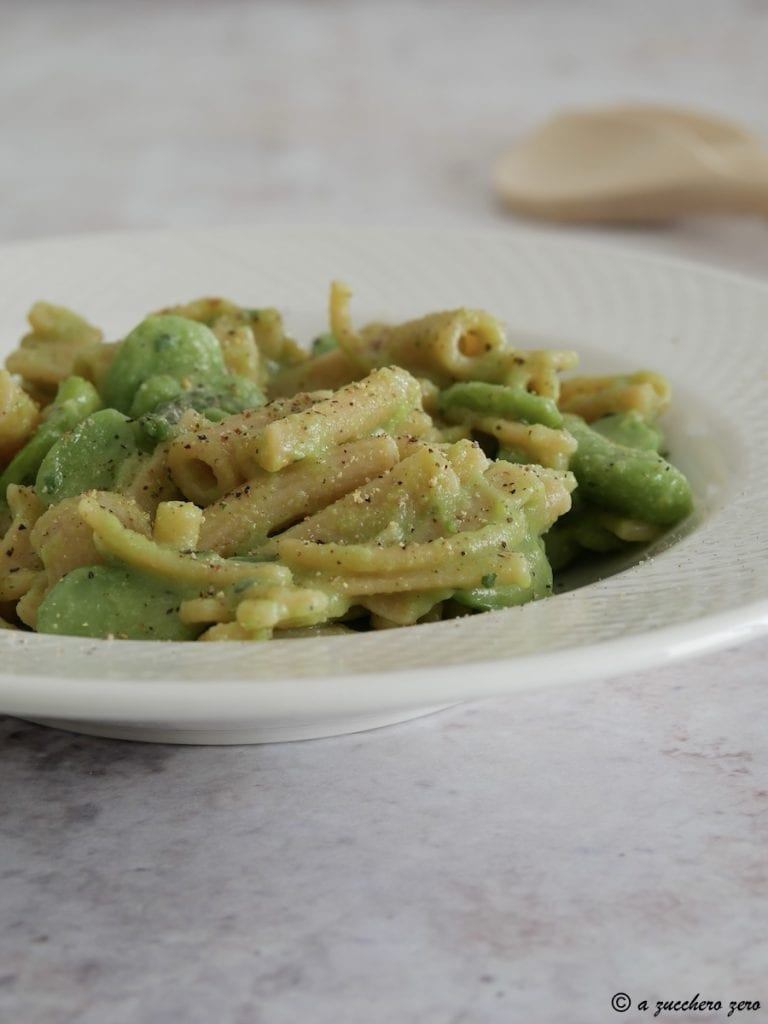The creamy pasta with fava beans and asparagus prepared with fresh fava beans and wild asparagus is a spring dish.
Delicious!
FAVA BEANS AND DIABETES
– Can diabetics eat fava beans?
The glycemic index of fava beans [GI 40] is higher than that of other legumes and increases with cooking.
In case of hyperglycemia, prediabetes, and diabetes, cooked fava beans should be consumed in moderation [always according to your dietary plan, ours includes them].
As generally suggested by Professor Enzo Bonora
It is important, in any case, in the presence of diabetes, to build experience on the impact of this and all other foods on blood sugar. It means measuring before and two hours after eating. Possibly more than once to get more reliable information. If the glycemic increase is contained [less than 50 mg], a ‘green label’ can be put on that type of food. Otherwise, better to forget it.

- Difficulty: Easy
- Cost: Affordable
- Portions: 2 People
- Cooking methods: Stove
- Cuisine: Italian
Ingredients
Fresh fava beans raw and cooked weight
From one kilogram of fresh fava beans [weight with pod], I obtained 375 g of fresh fava beans [without pod].
- 4.2 oz whole wheat mixed pasta
- fresh fava beans (2 portions as per dietary plan)
- as needed wild asparagus
- 0.4 cup water
- 1 vegetable bouillon cube (homemade)
- 4 parsley stems
- 1 pinch salt
- 1 pinch mixed peppercorns (with grinder)
- 0.4 cup water
- as needed chopped parsley
- 1 drizzle extra virgin olive oil (raw)
Suggested Tools
- 1 Saucepan
- Colander
- 1 Knife
- 1 Cutting Board
- 1 Glass graduated
- 1 Frying Pan
- 1 Immersion Blender with glass
- 1 Pot
Preparation
The guidelines for healthy eating indicate the following standard portions:
• fresh, soaked, or canned legumes 5.3 oz;
• dried legumes 1.8 oz.
⟹ remember that weights are personal.
Remove the fresh fava beans from the pod and rinse them under running water.
In a saucepan, bring the water to a boil.
Add the fava beans and blanch them for a few seconds.
Drain the fava beans and spread them on a kitchen towel, let them dry and cool for about a minute.Remove the skins.
Clean the wild asparagus:
• rinse the asparagus under running water and let them drain in a colander;
• separate the tips up to the most tender part of the stem and cut them into pieces;
• retrieve the shoots of the stalk discarding the thorns if there are any;
• remove the end of the stems that are cut and damaged.stems
With the end of the stems, we will flavor the pasta cooking water.In a graduated glass, pour:
• 100 ml of water;
• one vegetable bouillon cube;
and mix to dissolve it obtaining a vegetable broth.In a frying pan, add the previously blanched and peeled fava beans, turn on the heat, and quickly sauté.
Add:
• a few parsley stems;
• the vegetable broth;
bring to a boil and let simmer for 5 minutes and until the broth has evaporated.
Season with a pinch of salt and grind the pepper then mix.Transfer half of the fava beans to a tall, narrow glass, add 100 ml of water and blend with an immersion blender until obtaining a smooth green fava bean cream.
Pour the fava bean cream into the frying pan and mix with the whole fava beans.Add the asparagus and chopped parsley and incorporate.
In a pot, bring salted water to a boil along with the asparagus stems and remove them before adding the pasta.
Cook the pasta, rinse it under running water and drain it.
Meanwhile, heat the fava bean and asparagus cream.Pour the pasta into the pan with the fava bean and asparagus cream and mix.
Plate.
Add a drizzle of oil and grind a bit more pepper.Your creamy pasta with fava beans and asparagus is ready.
Enjoy your meal!

If you don’t have wild asparagus or can’t find them, you can use frozen asparagus tips.
Tips on how to pair legumes
The combination with pasta, rice, or other cereals allows better absorption of legume proteins.
The cereals included in these dishes, in fact, compensate for the amino acids missing in legumes, allowing for a complete amino acid pool.
Choose cereals preferably whole grain.
To learn more: how to pair legumes in the diet.
FAQ (Frequently Asked Questions)
Can diabetics eat fava beans?
The glycemic index of fava beans [GI 40] is higher than that of other legumes and increases with cooking.
In case of hyperglycemia, prediabetes, and diabetes, cooked fava beans should be consumed in moderation [always according to your dietary plan, ours includes them].
As generally suggested by Professor Enzo Bonora
It is important, in any case, in the presence of diabetes, to build experience on the impact of this and all other foods on blood sugar. It means measuring before and two hours after eating. Possibly more than once to get more reliable information. If the glycemic increase is contained [less than 50 mg], a ‘green label’ can be put on that type of food. Otherwise, better to forget it.How to make fava beans more digestible?
It is better to use small and tender fava beans; in any case, in this preparation, the fava beans are peeled and blended.
How to reduce legume fibers?
It is better to use small and tender fava beans; in any case, in this preparation, the fava beans are peeled and blended.
Can I use frozen asparagus?
You can use frozen asparagus instead of fresh asparagus.
They are already cleaned and cut.
Follow the instructions on the purchase package.

